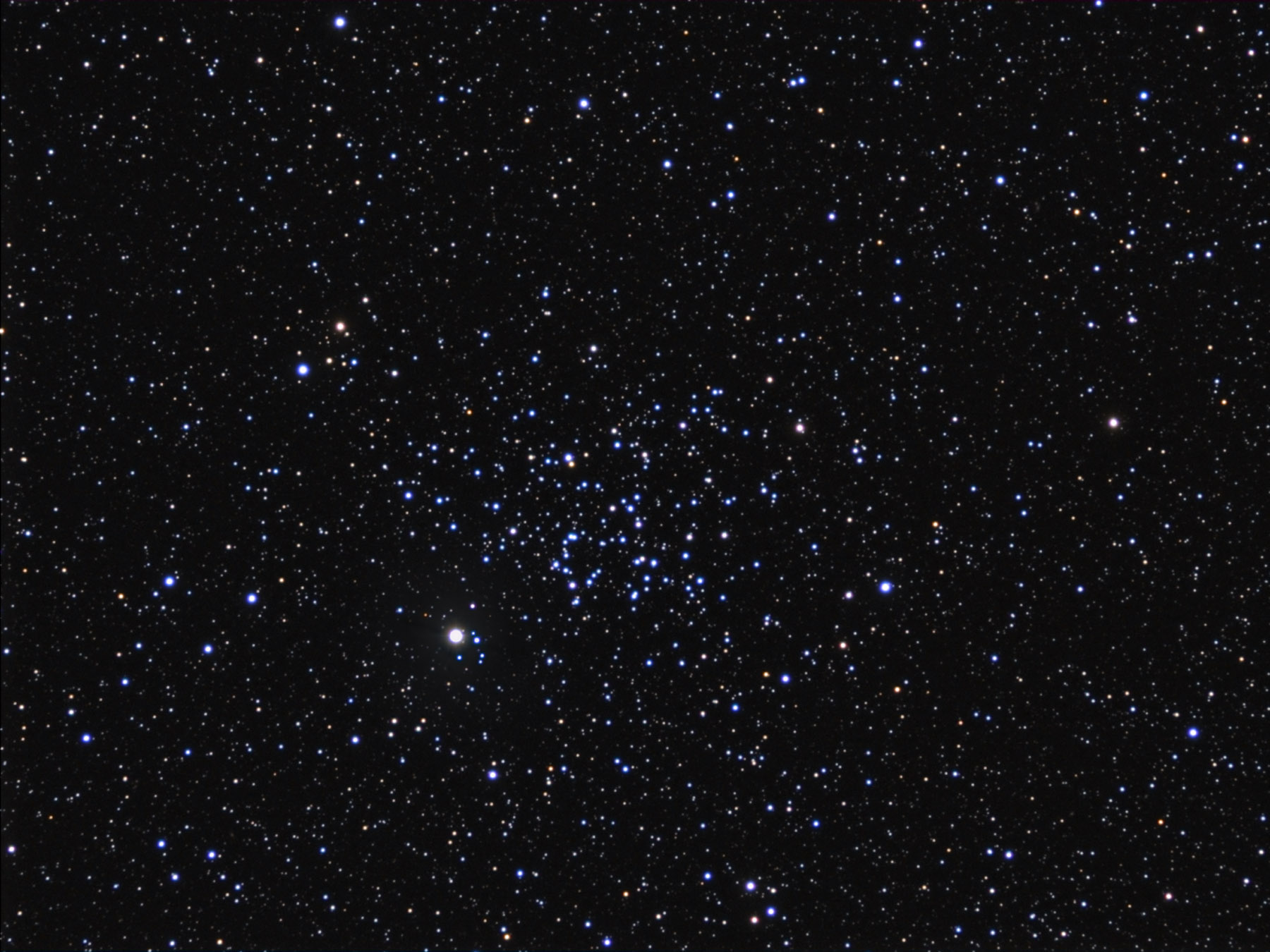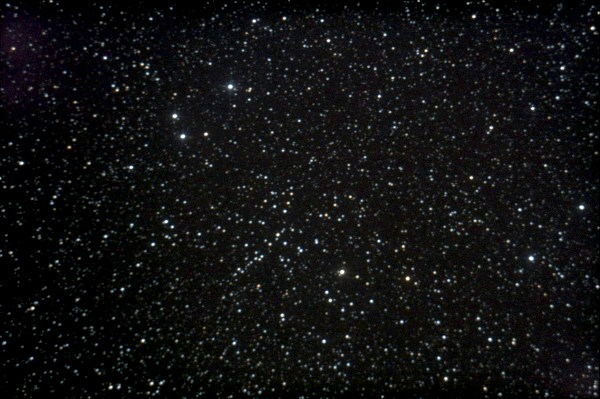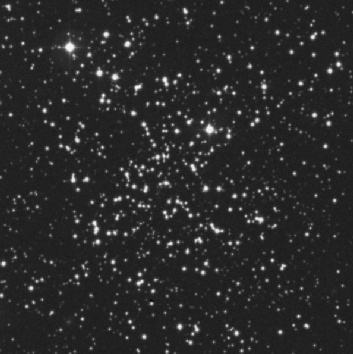STARLOG
BLASTING BARNACLES OFF THE ARGO - PART 2
FEBRUARY 24, 2017
| Observer: |
Tom Campbell |
| Location: |
College Station, Texas (Long: 96°17'W Lat: 30°37'N) |
| Equipment: |
Zhumell 12" f/5 Dobsonian
Sears 10x50 binoculars |
| Eyepieces: |
Zhumell 30mm (50x)
Explore Scientific 18mm (84x)
Explore Scientific 11mm (138x) |
| Lenses: |
Celestron Luminos Barlow (2.5x) |
| Weather: |
The sky was mostly clear. Temperature was in the mid 60s (F), with a slight breeze, turning cooler and damper as evening progressed. |
OBSERVING SUMMARY:
MONOCEROS: NGC 2324
ORION: W Ori
PUPPIS: NGC 2421, NGC 2479, NGC 2482, NGC 2509, NGC 2539
VELA: IC 2391
Tonight was clear, but there was a northerly breeze that was getting cooler and stronger as the night wore on. I did want to try to take advantage of the clear skies, however, so I set up in the back yard, trying to use my house as a shield from the worst of the wind.
First up on my list was W Orionis. This is a carbon star in the constellation of Orion, and was the first star recognized as a "carbon star," meaning that it contains a lot of carbon in its atmosphere.
| W Ori |
Orion |
Carbon Star |
8:14pm CST |
This is a nice yellow-orange color. Not quite as deep as Hind's Crimson Star, which I saw the other night. |
| |
There were several more open clusters in Puppis that I wanted to take a look at. I aimed my telescope down towards the southern horizon and continued my quest.
| NGC 2539 |
Puppis |
Open Cluster |
8:26pm CST |
 |
This cluster is right off 19 Puppis. It is easy to find by drawing a line from M 48 to Rho Puppis and going about 1/3 of the way. The best view was with the 11mm eyepiece (138X), where it almost fills the field of view. The stars are somewhat faint, fairly compact, and very rich. The cluster probably has 50-60 stars. This was my 1,000th logged observation! |
| |
| NGC 2482 |
Puppis |
Open Cluster |
8:37pm CST |
 |
This cluster is dim, but easy to see. You can see a couple of nearby stars in the finder scope. The cluster is roughly triangular. There is a line of stars, irregularly spaced, that form a straight line running all the way from end to end. A nice "eyeball" double is nearby. |
| |
| NGC 2421 |
Puppis |
Open Cluster |
8:48pm CST |
 |
The best view of this cluster is with the 11mm (138X). The cluster is faint, somewhat compact, with perhaps 20-30 stars visible. It seems there are a lot more stars just below the limit of detectability. Kicking up the power to my barlowed 18mm made the cluster larger, but didn't really reveal more stars. There is a pair of stars near the center of the cluster. They are surrounded by lines of stars that form a fish. The pair of stars would be the gills. |
| |
| NGC 2324 |
Monoceros |
Open Cluster |
9:07pm CST |
 |
On my observing list, I had mistakenly put this cluster in Puppis instead of Monoceros where it belongs. No matter, they're all worth looking at. Using the barlowed 18mm (211X) reveals a rich cluster that's hard to resolve fully. This cluster is right on the edge of some foreground stars that are a lot brighter. I could detect a dozen stars with direct vision, mostly along the cluster's edges. The center of the cluster appeared a bit nebulous, indicating several more unresolved stars. |
| |
| NGC 2509 |
Puppis |
Open Cluster |
9:37pm CST |
 |
This is another small, faint, compact cluster. This one looks best at 11mm (138X), revealing several stars and hinting at several more just out of range of my telescope. |
| |
| NGC 2479 |
Puppis |
Open Cluster |
9:58pm CST |
 |
This cluster is right in the midst of the Milky Way. I had to double-check the star atlas to make sure I was looking at the right little knot of stars. The cluster is fairly rich with faint stars. The cluster is semi-compact. There is an optical double right off one edge that point to the cluster. The cluster is oblong and hte middle section seems to be he richest. The best view was with the 18mm (84X), where the field is wide enough to distinguish this cluster from background stars. |
| |
That marked the end of the open clusters I had on my list tonight, and the wind was really starting to get cold. I started this observing session wearing a denim jacket. By now, I had a winter coat, hood and gloves on. A successful night, nonetheless.
I packed up my telescope and began transporting them back into the garage. It usually takes me three trips to get everything in - one for the observing chair (and a free hand to unlatch the fence gate and open the garage door), one for my eyepiece case and folding table, and one for the telescope. I could get a wagon and do it all in 2 trips, but I need the exercise.
As I was coming back to pick up my second load, I glanced up at the sky and saw how close to the horizon I could see when standing up. In fact, I could probably catch a few more objects, but my telescope sits too low to the ground to see them. But maybe I could catch one with binoculars.
After putting the telescope away, I went inside and grabbed my 10x50s. I went all around the yard looking for the best spot to see. Finally I found a spot that showed me what I was looking for between two houses.
| IC 2391 |
Vela |
Open Cluster |
10:34pm CST |
 |
This is very far south. It was too low to see with my telescope, but I could see it while standing and looking through binoculars. I saw 5 stars in a triangular pattern. 3 stars were forming one apex and the other two stars formed the other two points of the triangle. This didn't seem very impressive for a Caldwell object, but I'm happy I could even see it from here. |
| |
At a declination of -53°, IC 2391 would be high overhead right now at the southern tip of South America. And I could still see it barely above the horizon here. Awesome!






